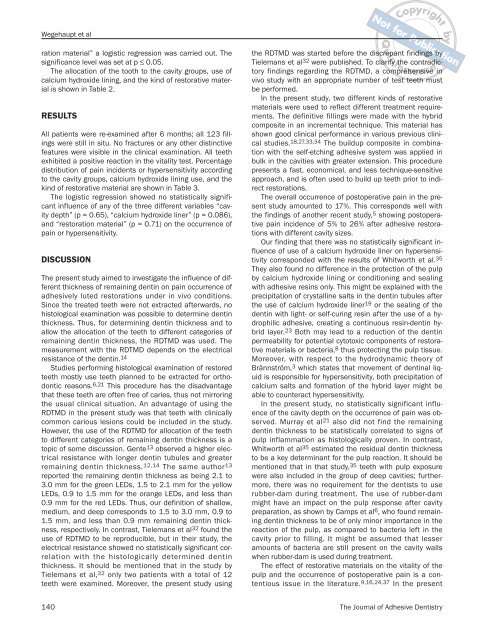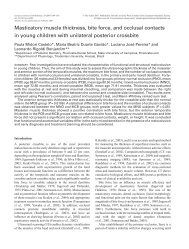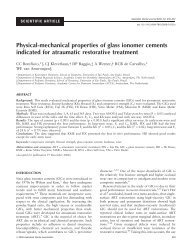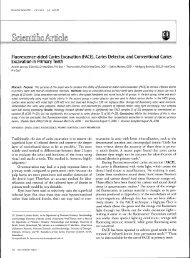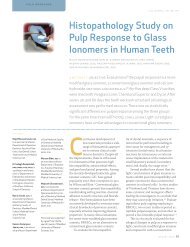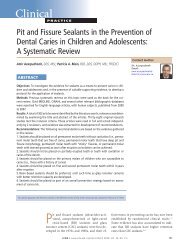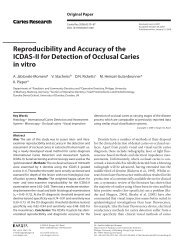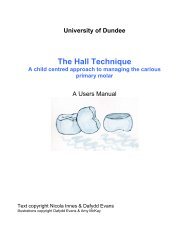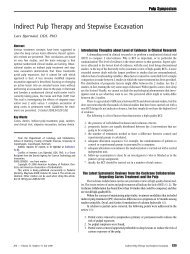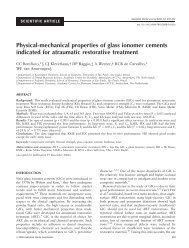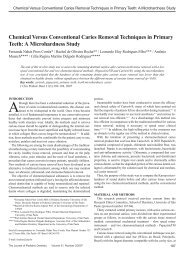Quintessence Journals - Sandra Kalil Bussadori
Quintessence Journals - Sandra Kalil Bussadori
Quintessence Journals - Sandra Kalil Bussadori
Create successful ePaper yourself
Turn your PDF publications into a flip-book with our unique Google optimized e-Paper software.
Copyright<br />
Wegehaupt et al<br />
ration material” a logistic regression was carried out. The<br />
significance level was set at p ≤ 0.05.<br />
The allocation of the tooth to the cavity groups, use of<br />
calcium hydroxide lining, and the kind of restorative material<br />
is shown in Table 2.<br />
RESULTS<br />
All patients were re-examined after 6 months; all 123 fillings<br />
were still in situ. No fractures or any other distinctive<br />
features were visible in the clinical examination. All teeth<br />
exhibited a positive reaction in the vitality test. Percentage<br />
distribution of pain incidents or hypersensitivity according<br />
to the cavity groups, calcium hydroxide lining use, and the<br />
kind of restorative material are shown in Table 3.<br />
The logistic regression showed no statistically significant<br />
influence of any of the three different variables “cavity<br />
depth” (p = 0.65), “calcium hydroxide liner” (p = 0.086),<br />
and “restoration material” (p = 0.71) on the occurrence of<br />
pain or hypersensitivity.<br />
DISCUSSION<br />
The present study aimed to investigate the influence of different<br />
thickness of remaining dentin on pain occurrence of<br />
adhesively luted restorations under in vivo conditions.<br />
Since the treated teeth were not extracted afterwards, no<br />
histological examination was possible to determine dentin<br />
thickness. Thus, for determining dentin thickness and to<br />
allow the allocation of the teeth to different categories of<br />
remaining dentin thickness, the RDTMD was used. The<br />
measurement with the RDTMD depends on the electrical<br />
resistance of the dentin. 14<br />
Studies performing histological examination of restored<br />
teeth mostly use teeth planned to be extracted for orthodontic<br />
reasons. 6,21 This procedure has the disadvantage<br />
that these teeth are often free of caries, thus not mirroring<br />
the usual clinical situation. An advantage of using the<br />
RDTMD in the present study was that teeth with clinically<br />
common carious lesions could be included in the study.<br />
However, the use of the RDTMD for allocation of the teeth<br />
to different categories of remaining dentin thickness is a<br />
topic of some discussion. Gente 13 observed a higher electrical<br />
resistance with longer dentin tubules and greater<br />
remaining dentin thickness. 12,14 The same author 13<br />
reported the remaining dentin thickness as being 2.1 to<br />
3.0 mm for the green LEDs, 1.5 to 2.1 mm for the yellow<br />
LEDs, 0.9 to 1.5 mm for the orange LEDs, and less than<br />
0.9 mm for the red LEDs. Thus, our definition of shallow,<br />
medium, and deep corresponds to 1.5 to 3.0 mm, 0.9 to<br />
1.5 mm, and less than 0.9 mm remaining dentin thickness,<br />
respectively. In contrast, Tielemans et al 32 found the<br />
use of RDTMD to be reproducible, but in their study, the<br />
electrical resistance showed no statistically significant correlation<br />
with the histologically determined dentin<br />
thickness. It should be mentioned that in the study by<br />
Tielemans et al, 32 only two patients with a total of 12<br />
teeth were examined. Moreover, the present study using<br />
Not for Publication<br />
<strong>Quintessence</strong><br />
the RDTMD was started before the discrepant findings by<br />
Tielemans et al 32 were published. To clarify the contradictory<br />
findings regarding the RDTMD, a comprehensive in<br />
vivo study with an appropriate number of test teeth must<br />
be performed.<br />
In the present study, two different kinds of restorative<br />
materials were used to reflect different treatment requirements.<br />
The definitive fillings were made with the hybrid<br />
composite in an incremental technique. This material has<br />
shown good clinical performance in various previous clinical<br />
studies. 18,27,33,34 The buildup composite in combination<br />
with the self-etching adhesive system was applied in<br />
bulk in the cavities with greater extension. This procedure<br />
presents a fast, economical, and less technique-sensitive<br />
approach, and is often used to build up teeth prior to indirect<br />
restorations.<br />
The overall occurrence of postoperative pain in the present<br />
study amounted to 17%. This corresponds well with<br />
the findings of another recent study, 5 showing postoperative<br />
pain incidence of 5% to 26% after adhesive restorations<br />
with different cavity sizes.<br />
Our finding that there was no statistically significant influence<br />
of use of a calcium hydroxide liner on hypersensitivity<br />
corresponded with the results of Whitworth et al. 35<br />
They also found no difference in the protection of the pulp<br />
by calcium hydroxide lining or conditioning and sealing<br />
with adhesive resins only. This might be explained with the<br />
precipitation of crystalline salts in the dentin tubules after<br />
the use of calcium hydroxide liner 19 or the sealing of the<br />
dentin with light- or self-curing resin after the use of a hydrophilic<br />
adhesive, creating a continuous resin-dentin hybrid<br />
layer. 23 Both may lead to a reduction of the dentin<br />
permeability for potential cytotoxic components of restorative<br />
materials or bacteria, 8 thus protecting the pulp tissue.<br />
Moreover, with respect to the hydrodynamic theory of<br />
Brännström, 3 which states that movement of dentinal liquid<br />
is responsible for hypersensitivity, both precipitation of<br />
calcium salts and formation of the hybrid layer might be<br />
able to counteract hypersensitivity.<br />
In the present study, no statistically significant influence<br />
of the cavity depth on the occurrence of pain was observed.<br />
Murray et al 21 also did not find the remaining<br />
dentin thickness to be statistically correlated to signs of<br />
pulp inflammation as histologically proven. In contrast,<br />
Whitworth et al 35 estimated the residual dentin thickness<br />
to be a key determinant for the pulp reaction. It should be<br />
mentioned that in that study, 35 teeth with pulp exposure<br />
were also included in the group of deep cavities; furthermore,<br />
there was no requirement for the dentists to use<br />
rubber-dam during treatment. The use of rubber-dam<br />
might have an impact on the pulp response after cavity<br />
preparation, as shown by Camps et al 6 , who found remaining<br />
dentin thickness to be of only minor importance in the<br />
reaction of the pulp, as compared to bacteria left in the<br />
cavity prior to filling. It might be assumed that lesser<br />
amounts of bacteria are still present on the cavity walls<br />
when rubber-dam is used during treatment.<br />
The effect of restorative materials on the vitality of the<br />
pulp and the occurrence of postoperative pain is a contentious<br />
issue in the literature. 9,16,24,37 In the present<br />
for<br />
Not<br />
by<br />
140 The Journal of Adhesive Dentistry


